Use this Lavender Chiffon Rose of Sharon (Hibiscus syriacus) guide to grow this pretty flowering perennial shrub with a long season of continuous blooms! Easy to maintain and pollinators love it!

I love Rose of Sharons — any and every one — all colors, shapes and sizes.
If I could have all of them in my gardens, I would!
Alas, I can’t. So I have to choose carefully, and with garden plants — as you no doubt will agree with me — it’s sometimes next to impossible to choose.
Table of Contents
- Rose of Sharon Sterile Varieties
- Helene Rose of Sharon
- Neat background history of the Rose of Sharon Chiffon Series
- Highlights about Lavender Chiffon Rose of Sharon
- Lavender Chiffon Rose of Sharon Flowers
- Lavender Chiffon Rose of Sharon Size
- Hardiness Zones
- Lavender Chiffon Rose of Sharon Growth Rate
- Lavender Chiffon Rose of Sharon Bloom Time
- Does Lavender Chiffon like heat for blooming?
- Sun
- Water
- Soil
- Fertilizer
- Pruning Lavender Chiffon Rose of Sharon
- Can you propagate Lavender Chiffon by stem cuttings?
- Pests: Bugs? Deer? Rabbits?
- Lavender Chiffon Rose of Sharon in Fall
- Lavender Chiffon in Winter
- So far, so good!
- Where to Buy Lavender Chiffon Rose of Sharon
Rose of Sharon Sterile Varieties
Much older varieties of Rose of Sharons not only produced seeds, but produced them so prolifically that gardeners spent quite a bit of time just pulling seedlings out from around the main plant.
(I discuss this more in my article about Helene Rose of Sharon.)
Today there are newer Rose of Sharons on the market that produce little to no seeds!
Sometimes a little improvement by plant breeders on Mother Nature’s creations isn’t a bad thing.
When I first did my research and came upon the hybrids produced by the US National Arboretum — which “produce little to no seeds” — I chose the Helene variety. And I have yet to see any seedlings since we planted it years ago.
Now I’m excited about our new Lavender Chiffon, which is a sterile cultivar, meaning it doesn’t produce seeds. (I see that Proven Winners, which sells Lavender Chiffon here in the US, says it “produces few to no seeds.”)
Important tip: If shopping for a Rose of Sharon, make sure to do your research and purchase plants that are either sterile or produce little to no seed. There are many beautiful varieties to choose from!
Helene Rose of Sharon
As I mentioned above, our first Rose of Sharon we purchased is called Helene. Other than accidentally trying to drown her, we are now getting along just fine.
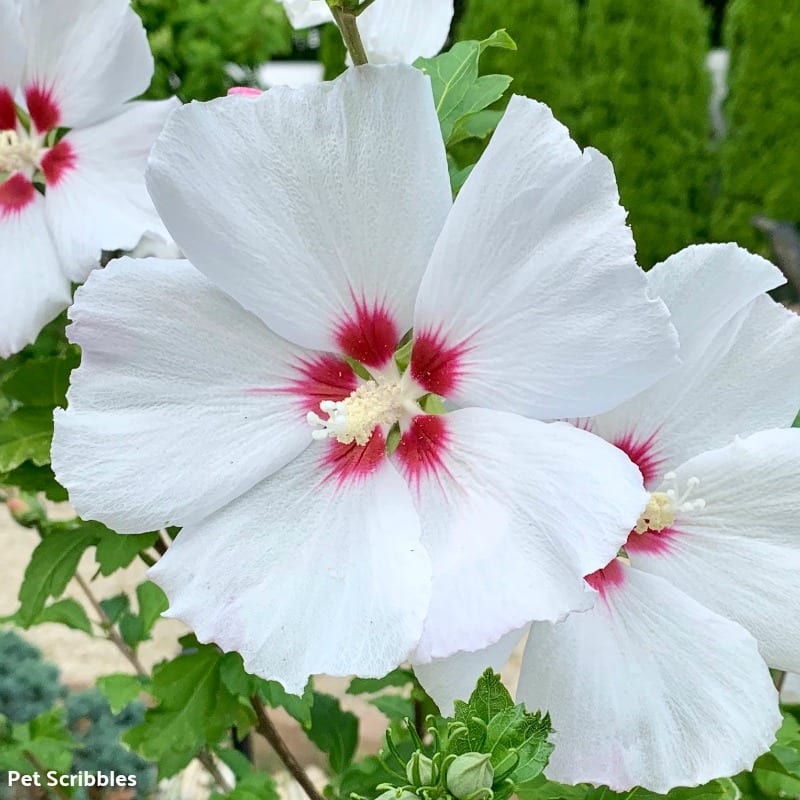
Although I love Helene, and she’s still got a little ways to go to become her best self, I wanted another Rose of Sharon. (Like I said, I couldn’t stop at just one!)
This time I wanted a bigger variety. My husband agreed, always a plus, so last year at the end of the Summer we purchased a Lavender Chiffon Rose of Sharon.
We picked out the perfect spot in our backyard garden and planted her, looking forward to this year to see how she would do.
(I’ll share how she’s doing so far in just a minute.)
Neat background history of the Rose of Sharon Chiffon Series
Lavender Chiffon Rose of Sharon is part of the Chiffon Series, developed and bred by Roderick Ian Woods in the United Kingdom.
The in-depth why and how is a neat story, and you can read an interesting article about Roderick Woods here.
In summary, Roderick Woods first had a successful career as a well-known physiologist for 32 years before retiring and focusing his energies on breeding Rose of Sharons, among other impressive pursuits such as inventing protective clothing innovations for firemen and others.
One day, back in 1981, Woods was in the south of France and spotted a unique pink Rose of Sharon that captivated him. Upon returning to the UK, he began his quest to find the exact pink Rose of Sharon. This eventually resulted in the development of the Chiffon Series over many years, and yes he eventually developed a Pink Chiffon!
Lavender Chiffon
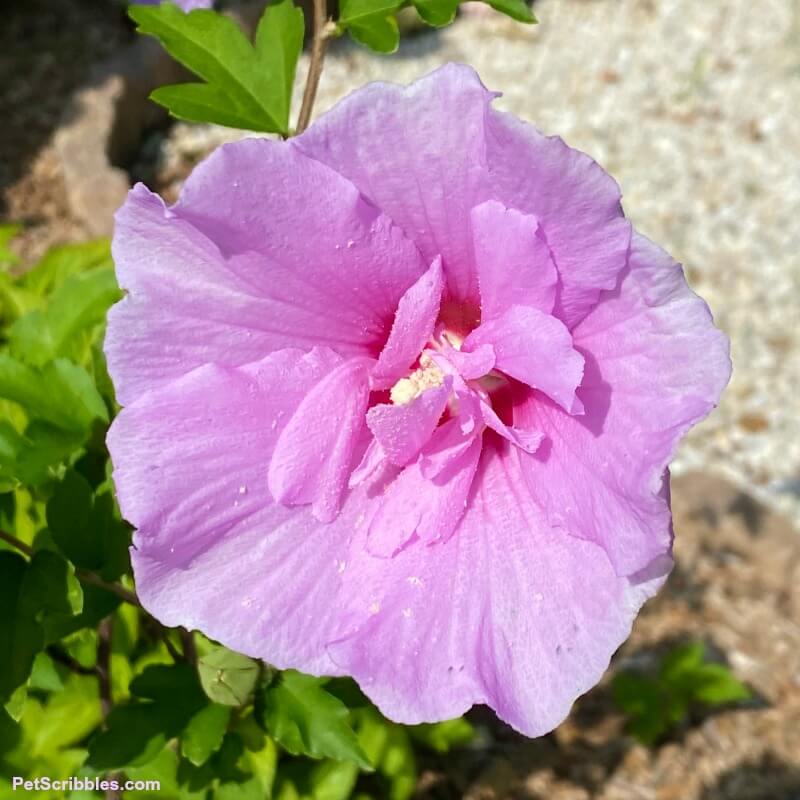
Blue Chiffon
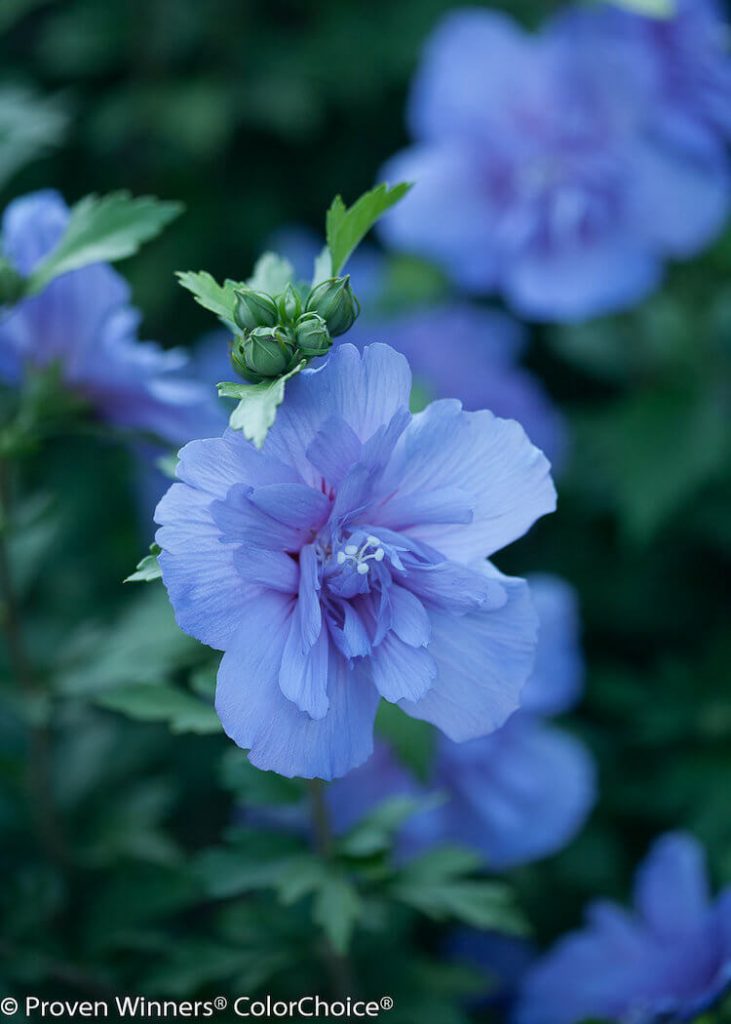
Pink Chiffon
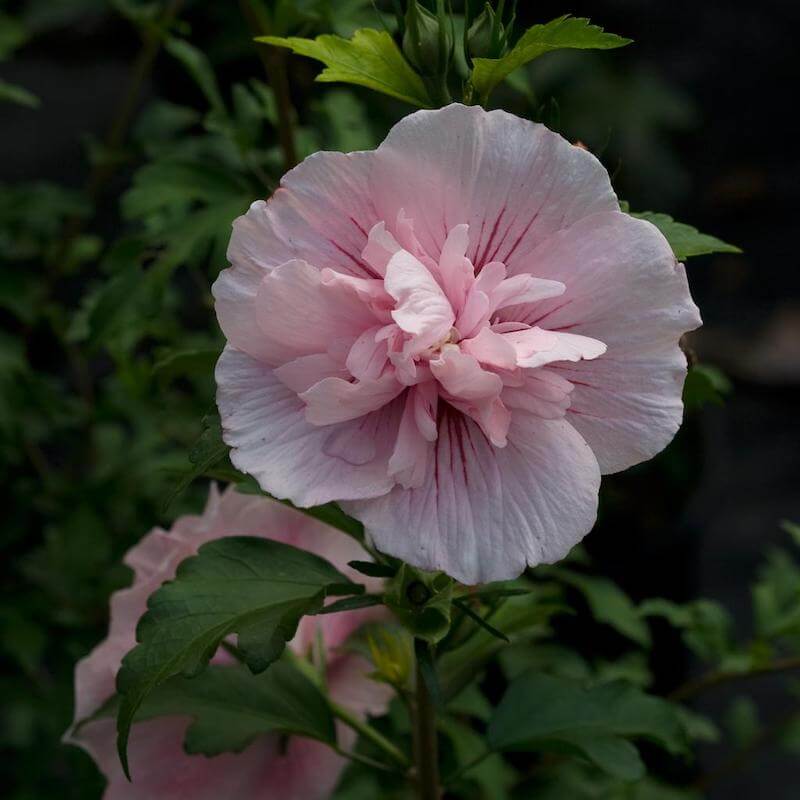
White Chiffon

Magenta Chiffon

Highlights about Lavender Chiffon Rose of Sharon
The official name is Hibiscus syriacus Lavender Chiffon.
This perennial shrub is also called an Althea shrub. (Yes, it seems every plant, flower, tree and shrub have several names!)
Another name variation you will see? Lavender Chiffon Hibiscus Rose of Sharon.
If you noticed the word “hibiscus” in the official name, yes this plant is a hardy perennial form of hibiscus.
Instead of purchasing an annual hibiscus plant every year to put on your patio, why not plant one of these instead?

Lavender Chiffon Rose of Sharon has wonderful features:
- has a long season of continuous blooms
- attracts hummingbirds, bees and butterflies
- handles heat and humidity
- easy to maintain
- produces little to no seeds
- deer resistant
Like all Rose of Sharons, Lavender Chiffon can be planted as a single featured shrub or in a group, for a flowering hedge or screen.
If you plant this shrub in a container, you will need to transplant it into your garden once the plant matures as it will outgrow the confined planted space of a pot.
Enjoy this happy bee on my Lavender Chiffon Rose of Sharon:
(Click “watch on YouTube” to view it in a larger format.)
Lavender Chiffon Rose of Sharon Flowers
The flowers of Lavender Chiffon consist of large lavender petals which are ruffled, with additional inner petals — smaller and also ruffled. Way down deep in the center is a fuchsia-colored eye barely seen behind the inner petals.

I’ve seen this shrub described as *semi-double* or *double* Lavender Rose of Sharon because of the pretty ruffled flowers.
In the center of each flower is an ivory-colored stalk which contains the pollen and nectar loved by bees, butterflies and hummingbirds.
These frilly flowers appear to be very delicate, yet they stand up to heavy rain and wind pretty well. (And we just had a tropical storm here last week!)
With the darker green foliage, the lavender blossoms really stand out.
Each flower lasts about one day, however this shrub flowers heavily so its appearance is always being covered in flowers.
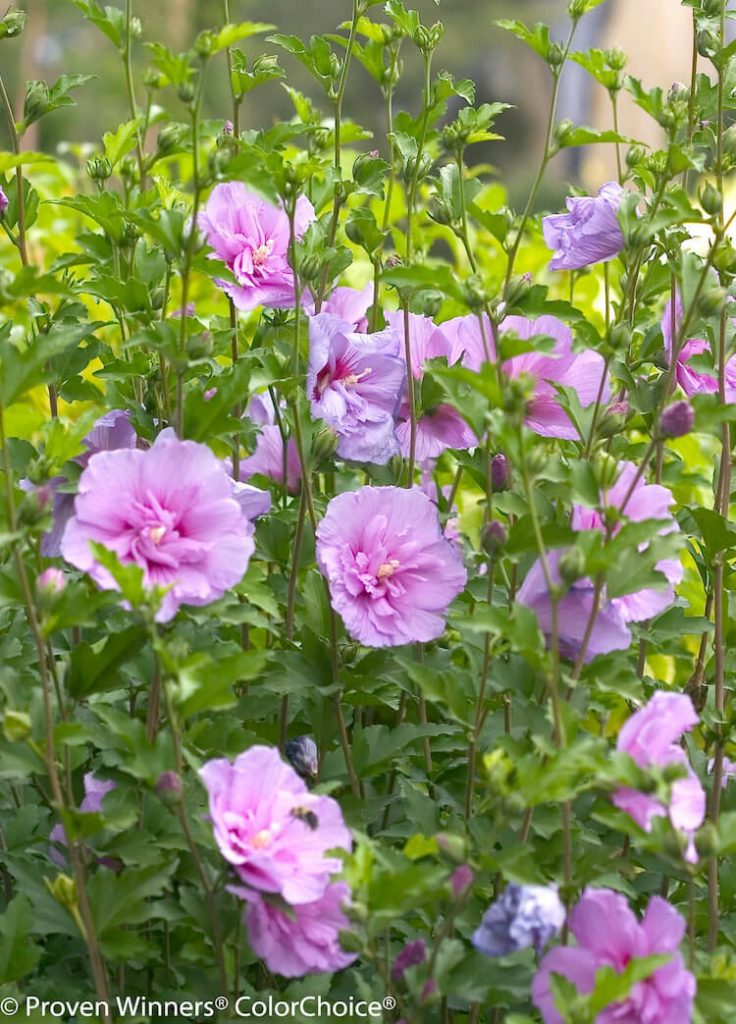
Like our other Rose of Sharon (Helene), Lavender Chiffon’s petals are textured, and look like crepe paper to me. Each flower, with its ruffled inner and outer petals, does resemble chiffon — thus the name.
When close up, the flowers seem slightly transparent:

These flowers just keep coming and coming, and provide dependable late-Summer color for your garden.
Lavender Chiffon Rose of Sharon Size
Lavender Chiffon Hibiscus Rose of Sharon shrub is deciduous (not evergreen). It has a vase-shaped, upright habit.
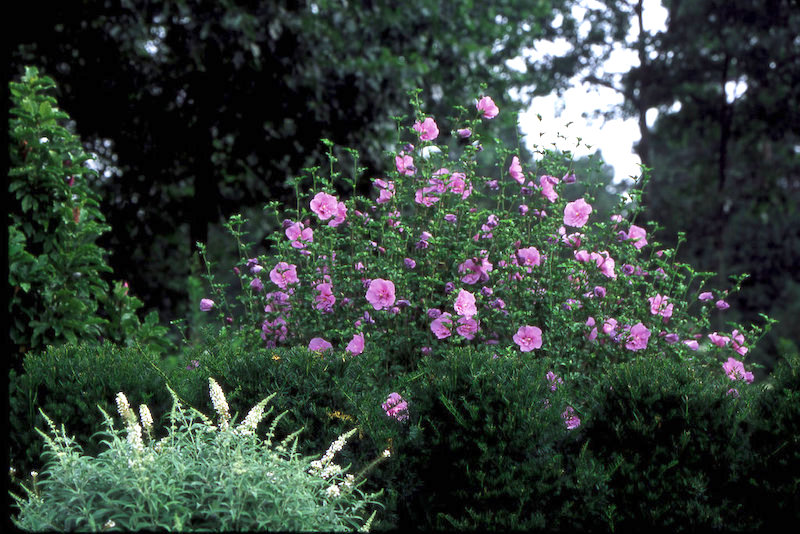
This shrub takes its time growing, and will reach a mature height between 8 and 12 feet tall. The spread is typically between 4 and 6 feet wide.
Keep these measurements in mind when you are planting your shrub so it has enough room to grow.
And if you’re planting a row of them, make sure to plan for sufficient spacing between shrubs. Plant them 6 to 7 feet apart from each other.
Lavender Chiffon Rose of Sharon Tree
You can prune and train Lavender Chiffon Rose of Sharon into a small flowering tree as well.
All of the care and growing guidelines in this article still apply.
Hardiness Zones
Lavender Chiffon Rose of Sharon is hardy in Zones 5 through 9, meaning in those zones it will come back each year in your garden, after a dormant Winter season.
It doesn’t leaf out right away in Spring, therefore be patient and rest assured Lavender Chiffon will be fine and showing leaf buds soon.
Lavender Chiffon Rose of Sharon Growth Rate
While most garden sites consider Rose of Sharons (in general) to be moderate growers, I view it as being a slow-growing shrub.
We planted ours last Fall, and it is not anywhere near 8 to 12 feet tall this year.
So don’t get frustrated with the slower growth, as you will eventually be rewarded with a gorgeous full-size flowering shrub.
In late Spring to early Summer (depending on your zone), new leaves will appear seemingly overnight, from the bottom to the top of each stem.

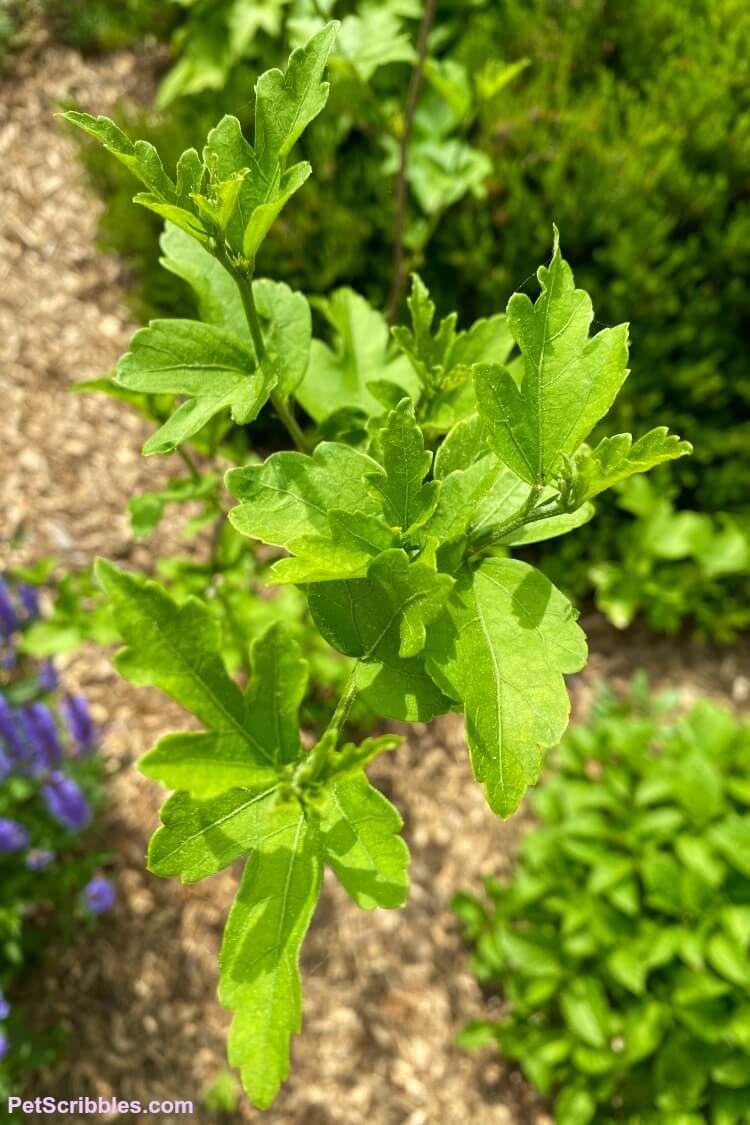
Look closely at your shrub and you will see new stems forming from the main stems as well.

Lavender Chiffon Rose of Sharon Bloom Time
Lavender Chiffon Rose of Sharon begins blooming in mid-Summer. It has a long blooming period, usually from July to October.
As mentioned earlier, it is slow to wake up in the Spring, so give it time.
For us in southern New Jersey (zone 7), the new leaf growth began in earnest during early June.
Just three weeks later, flower buds appeared.

Does Lavender Chiffon like heat for blooming?
Yes. More direct sun and heat will result in better branching and more flowers. The shrub will also remain somewhat shorter.
Rose of Sharons grow taller with a bit of shade, as they reach to find the sun. These are heat-loving plants that are good with humidity.
In general, Rose of Sharons provide welcome color in the latter half of Summer, when many flowers have already finished up their season of bloom.

Sun
Lavender Chiffon Rose of Sharon needs at least six hours of sun each day for optimal blooming. Partial sun/shade is ok, but the best flowering occurs in full sun.
Water
Lavender Chiffon prefers medium moisture.
During the first growing season while Lavender Chiffon gets established, make sure to water well. After a few years, it will be more drought tolerant, however water is always welcome.
Lavender Chiffon is also salt tolerant, meaning it can handle leftover salt from Winter sidewalks and roads as well as landscapes near the shore.
The flower petals of Lavender Chiffon handle rain well too, so no worries when watering your flowers.
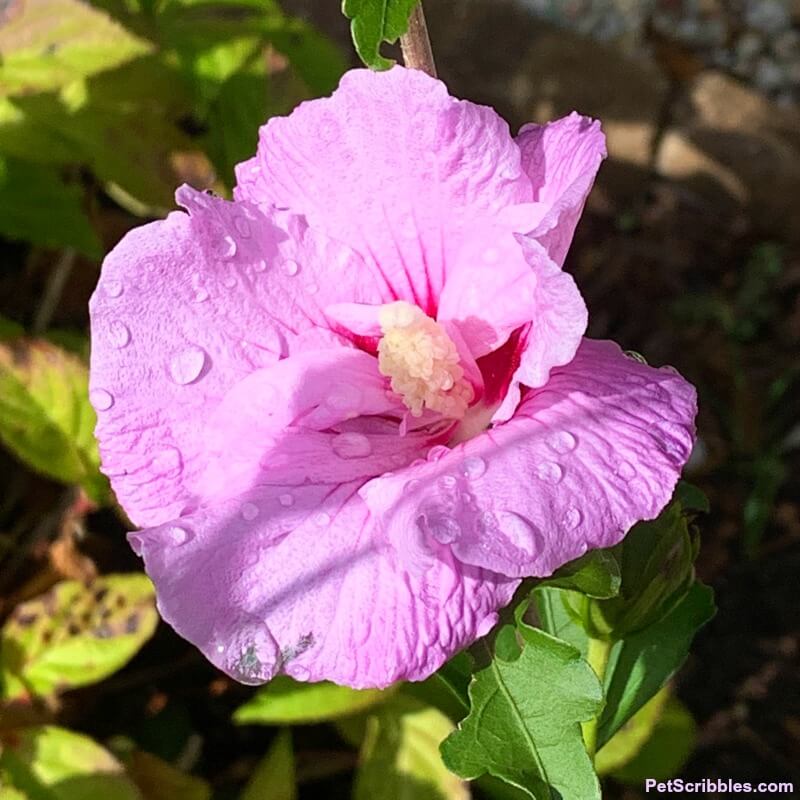
Soil
Moist, well-draining soil is best. Not too wet or too dry.
Fertilizer
Use an organic, slow-release fertilizer formulated for trees and shrubs in early Spring.
I use Espoma Plant Tone.
Pruning Lavender Chiffon Rose of Sharon
The best time to prune Lavender Chiffon Rose of Sharon is in the Winter or very early Spring while the plant is dormant.
Flowers form on new growth, so you can prune the shrub down a lot in size or just a little bit.
I pruned ours just a tiny bit to encourage more branching this year. (And by tiny, I mean I cut a few inches off of the still-short stems.
Is pruning necessary?
The breeder himself recommends cutting back the shrubs hard every six years to reinvigorate flowering.
Can you propagate Lavender Chiffon by stem cuttings?
Yes, Lavender Chiffon is easily grown by stem cuttings.
I look forward to trying this when I have more stems to cut. (I’m looking at you, Pandemic Rabbits.)
Pests
Bugs
Nothing major, but check your Rose of Sharon periodically for aphids, spider mites, Japanese beetles or whiteflies.
Spray with an insect spray meant for organic gardening. Espoma has several organic options.
Deer
According to Rutgers University, Rose of Sharons are rarely damaged by deer, so the shrub is considered deer resistant. However, keep in mind that hungry deer will munch on anything.
Rabbits
Lavender Chiffon Rose of Sharon is not rabbit resistant. Apparently, the new stems and shoots are a tasty salad bar for rabbits, judging from the gnawing they did earlier this season.
This year, in particular, has been a constant battle with the rabbits. I call them Pandemic Rabbits, and wrote about them in my Black Eyed Susans article.
The shrub looks a bit sparse in this photo because of the Pandemic Rabbits. This is when I realized they liked Rose of Sharons.

The rabbits must have either stood on their hind legs or on top of each other to reach some of those leaves and branches.
I can just imagine it, because they aren’t just any rabbits: they are the Pandemic Rabbits.
Liquid Fence for Deer and Rabbits seems to work the best out of the various products I’ve tried.
I spray it onto the lowest parts of the shrub and around the shrub after it rains. This Summer it seems to rain all the time, so if I’m not out there immediately . . .
Well, let’s just say I don’t have any marigolds anymore.
And yes, rabbits supposedly do not like marigolds.
But the Pandemic Rabbits do.
Sigh.
Lavender Chiffon Rose of Sharon in Fall
The flowers of Lavender Chiffon keep on blooming well into the Fall season, and look lovely in the Fall garden.
Even the spent blossoms look lovely, with a background of Japanese Anemone flowers.

Lavender Chiffon in Winter
Lavender Chiffon Hibiscus Rose of Sharon is a deciduous perennial shrub, meaning it loses its leaves and goes dormant in Winter.
During the Winter season, however, Rose of Sharon keeps its vase-shaped habit and provides Winter interest with tall stems and dried seed pods.

Seed pods are a pretty element when they stay on the plant. Here is one that is texturally intricate up close:

So far, so good!
I’m pretty pleased with how our Lavender Chiffon has performed this year, especially with the crazy weather we’ve had so far: severe storms, extreme heat and humidity plus one tropical storm. And those Pandemic Rabbits.
The growth isn’t that high, not even four feet, however this was from me trimming a few inches off to encourage branching plus the rabbits taking two of the larger stems off. (Yes, I almost cried the day it happened.)

I love the spot we chose in our backyard. It’s growing in the same garden bed as our Limelight Hydrangea Tree, which as you can see below is a pretty combination.
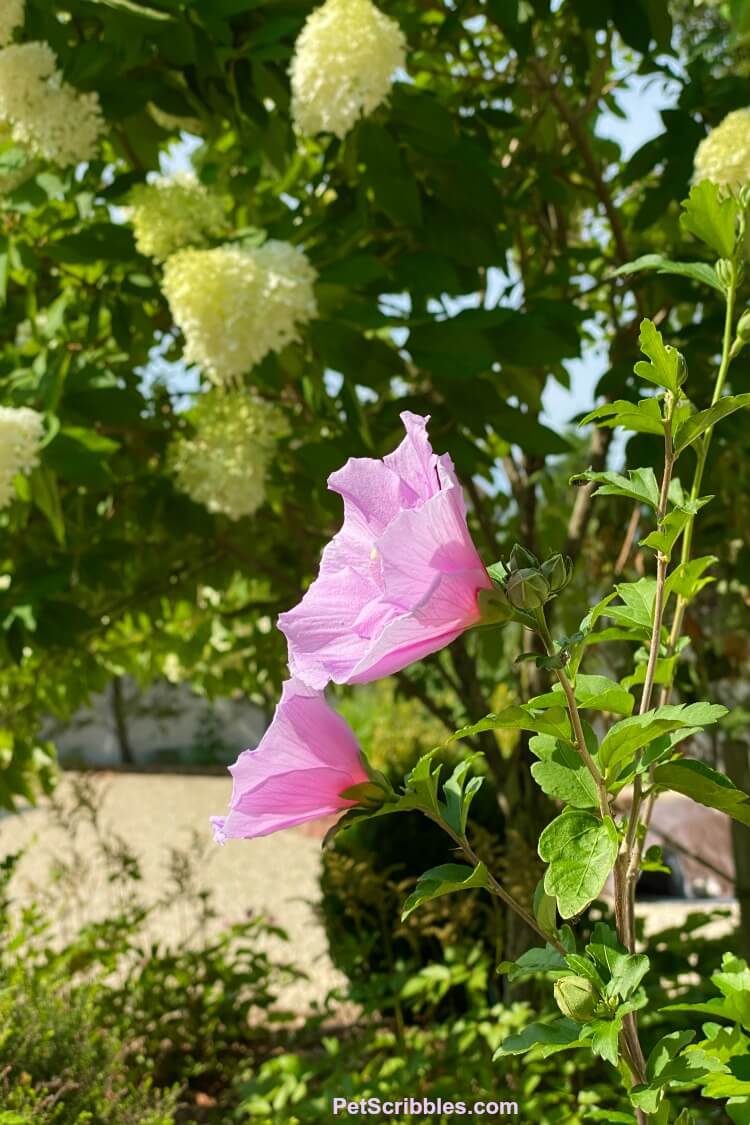
What will I do about the rabbits?
I will plant rabbit-resistant perennials around the base of the shrub. I’m considering Lamb’s Ears, Catmint, Artemisia — plants that are on the shorter side is what I want.
I’m hoping to figure this out soon so that I can plant something in the Fall.
And trust me, I’m triple-checking any source that says something is rabbit *resistant* too.
Where to Buy Lavender Chiffon Rose of Sharon
Garden Centers and Nurseries
Often times you may see this shrub referred to as Proven Winners Lavender Chiffon Rose of Sharon because the Chiffon Series is sold by Proven Winners.
Nurseries and garden centers which carry Proven Winners plants and shrubs should be able to order this for you, if they don’t already have it in stock.
Online
You can also order directly via Proven Winners.

Happy gardening!

Can I keep these in a big flower pot or do I have to plant them in the ground?
Hi John — you can definitely keep Lavender Chiffon in a big flower pot! And “big” is the good description, since you’ll not want to have to replant your Rose of Sharon anytime soon once you have it in the big pot, so make sure to use a pot with plenty of room for the plant to grow and develop. For the Winter season, you’ll want to either put this plant in a garage or shed, or next to your house in a sheltered spot. Pots tend to dry out quickly, so make sure to give it just a bit of water from time to time, if the Winter doesn’t provide rain and snow naturally. Keeping it sheltered helps protect it from winds which will dry out the pot and possibly break off the stems. I hope this helps!